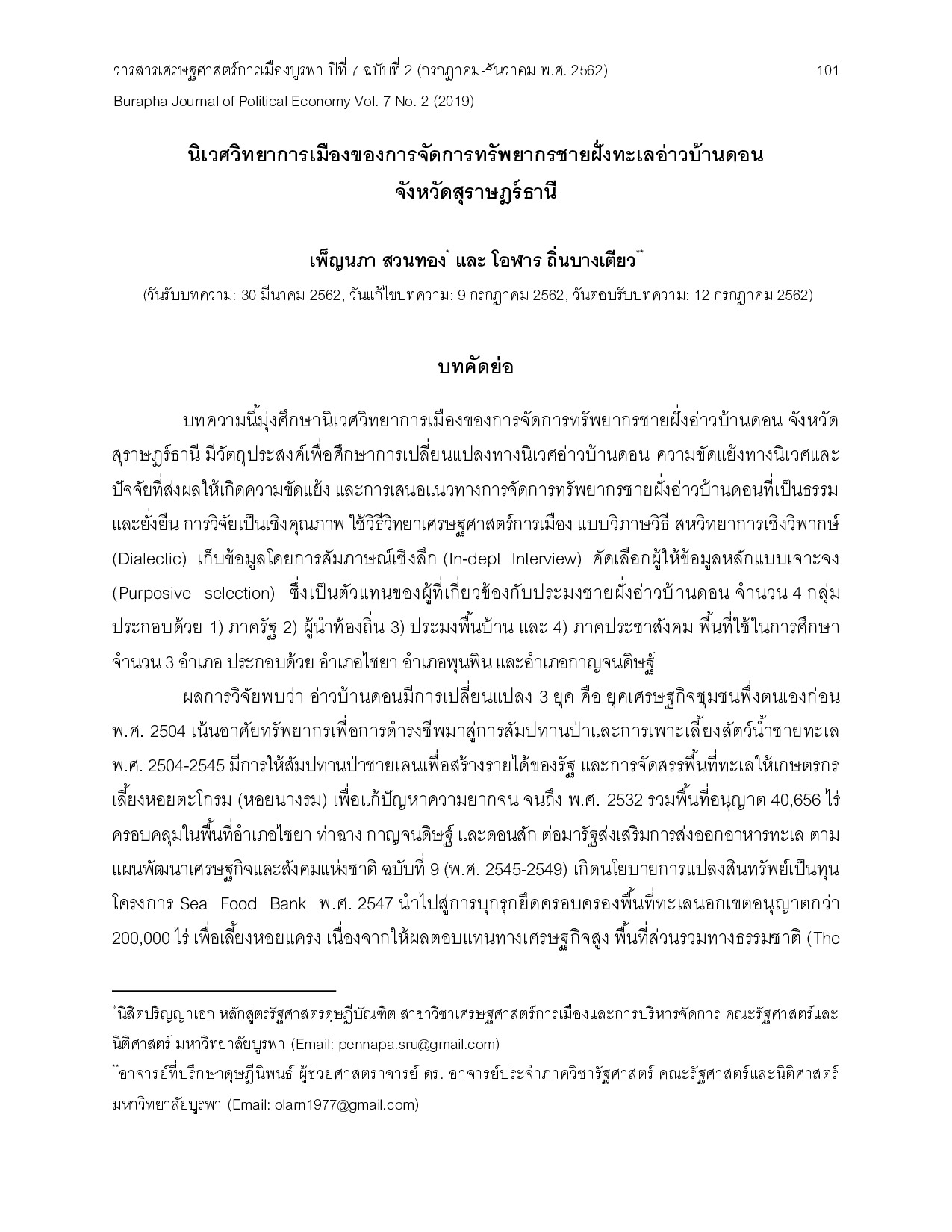The Political Ecology of the Coastal Resources Management in Bandon Bay, Surat Thani Province
Keywords:
Political Ecology, Ecological Conflicts, The Coastal Resources Management, Bandon BayAbstract
This article aims to study the political ecology of the coastal resource management in Bandon Bay at Surat Thani. The purposes of study are to study the ecological changes in Bandon Bay, the ecological conflict, and the factors affecting to the conflict. This study also offers the guideline of the coastal resource management justly and sustainably. The study is a qualitative research by using the methods of dialectic, interdisciplinary political economy, and in-dept interview. The participants are selected purposively from 4 groups of representatives involved in the coastal fishing in Bandon Bay namely 1) government officers 2) local leaders 3) local fishermen, and 4) community people. The areas for collecting the data are in 3 districts namely Chaiya, Phunphin, and Kanjanadit.
The study shows that there are 3 era changes in Bandon Bay. Firstly, prior 1961 it is called Self-Sufficiency Economy which people normally depended on natural resources for living until forest concession and aquaculture came. Later in 1961-2002, there was the mangrove forest concession for the government income and also aquaculture concession area of oyster farm for solving poor problem until 1989. The total concession area was 40,656 rai covering districts of Chaiya, Thachang, Kanjanadit and Donsak. Later, in 2002-2006, according to the Ninth National Economic and Social Development Plan, the government supported sea food export. Then, there was a policy of the property change to capital named Sea Food Bank project in 2004. Accordingly, there was the trespass of outside permitted area more than 200,000 rai for doing cockles farms which gave them high economic returns. Finally, the common natural areas turned to become private property affecting to local fishery for living since they were unable to do fishing in the common natural area. Accordingly, there were 3 groups of conflict namely existence rights of the poor (local people), an influential group who wanted to keep the resources for their own accumulation, and the controllers who legally managed all resources. The natural resource management which was run by the government and law powers may not assist the community people to make the benefits of non-property or open access areas justly and sustainably. Therefore, the fishermen community should manage their own natural resources (self-governance) and share their rules for the balance of bay use.
References
เอกสารภาษาไทย
ฉวีวรรณ ประจวบเหมาะ. (2536). แลใต้สี่ทศวรรษ : ความเปลี่ยนแปลงทางสังคมและพัฒนาการทางการเมือง (ในช่วง 2490-2536). กรุงเทพฯ: ม.ป.ท.
ชลิตา บัณฑุวงศ์. (2543). “หัวโทง”: พัฒนาการ ลักษณะ และการปรับตัวของชาวประมงพื้นบ้านอันดามัน.กรุงเทพฯ: ชนนิยม.
ไชยณรงค์ เศรษฐเชื้อ. (2559). “อันดามัน: นิเวศวิทยาพื้นบ้าน การเมืองเรื่องความรู้ และความเป็นธรรมทางสังคมด้านสุขภาวะ.” วารสารวิจัยสังคม, 39 (2): 109-138.
ณรงค์ชัย เจริญรุจิทรัพย์. (2542). การมีส่วนร่วมของชาวประมงพื้นบ้านในการจัดการประมงโดยชุมชน: กรณีศึกษาอ่าวปากพนัง จังหวัดนครศรีธรรมราช.วิทยานิพนธ์วิทยาศาสตรมหาบัณฑิต, สาขาการประมง, มหาวิทยาลัยเกษตรศาสตร์.
นิภาพร รัชตพัฒนากุล. (2558). ประวัติศาสตร์เศรษฐกิจและสิ่งแวดล้อมอ่าวบ้านดอน: กรณีศึกษาการเพาะเลี้ยงสัตว์น้ำชายฝั่งระหว่างทศวรรษ 2490 ถึงทศวรรษ 2540. กรุงเทพฯ: สำนักงานสนับสนุนการวิจัย (สกว.).
บรรจง นะแส. (ม.ป.ป.). การแปลงสินทรัพย์เป็นทุน.กรุงเทพฯ :สำนักงานคณะกรรมการสิทธิมนุษยชนแห่งชาติ.
ปรีชา เปี่ยมพงศ์สานต์. (2538). เศรษฐศาสตร์การเมือง โลกทัศน์กับการวิเคราะห์ระบบและการเปลี่ยนแปลง. กรุงเทพฯ: จุฬาลงกรณ์มหาวิทยาลัย.
_______. (2541). นิเวศเศรษฐศาสตร์และนิเวศวิทยาการเมือง. กรุงเทพฯ: จุฬาลงกรณ์มหาวิทยาลัย.
_______. (2555). รื้อถอนการพัฒนา ความยั่งยืนทางนิเวศและความยุติธรรมทางสังคม. กรุงเทพฯ: บริษัท ก. พล (1966) จำกัด.
_______. (2561). เศรษฐศาสตร์การเมืองสีเขียวและนิเวศวิทยาการเมือง.ขอนแก่น: คณะมนุษยศาสตร์และสังคมศาสตร์ มหาวิทยาลัยขอนแก่น.
พรพันธุ์ เขมคุณาศัย. (2549). นโยบายรัฐและความขัดแย้งของชาวประมงพื้นบ้านชายฝั่งทะเลตะวันออกภาคใต้. ปริญญาปรัชญาดุษฎีบัณฑิต, สาขาไทศึกษา, มหาวิทยาลัยมหาสารคาม.
พระราชกฤษฎีกาจัดตั้งนิคมสหกรณ์ในท้องที่อำเภอกาญจนดิษฐ์และพระราชกฤษฎีกาจัดตั้งนิคมสหกรณ์ในท้องที่อำเภอท่าฉาง. (2519, 3 สิงหาคม). ราชกิจจานุเบกษา. เล่ม 93 ตอนที่ 99.
พระราชกำหนดการประมง พ.ศ. 2558. (2548, 13 พฤศจิกายน). ราชกิจจานุเบกษา. เล่ม 132 ตอนที่ 108 ก.
พระราชบัญญัติการเดินเรือในน่านน้ำไทย (ฉบับที่ 17) พ.ศ. 2560. (2560, 24 มกราคม). ราชกิจจานุเบกษา.เล่ม 134 ตอนที่ 10 ก.
พัชราภา ตันตราจิน. (2561). “ศึกษาความขัดแย้งในการใช้ทรัพยากรประมง: กรณีศึกษาวิถีการดำรงอยู่กับความขัดแย้งของชาวประมงชายฝั่ง.” วารสารการเมืองการบริหารและกฎหมาย, 10 (2): 356-398.
เลิศชาย ศิริชัย และคณะ. (2542). เรือปั่นไฟปลากะตักกับผลกระทบต่อทะเลและชุมชนประมงพื้นบ้าน.นครศรีธรรมราช: มหาวิทยาลัยวลัยลักษณ์.
เลิศชาย ศิริชัย. (2543). พัฒนาการชุมชนประมงพื้นบ้านในลุ่มทะเลสาบสงขลา: ศึกษากรณีชุมชนประมงพื้นบ้าน. กรุงเทพฯ:สำนักงานกองทุนสนับสนุนการวิจัย (สกว.).
_______. (2545). “ชุมชนประมงพื้นบ้านกับปัญหาการจัดการทรัพยากร.” ใน บรรจง นะแส (บก.). การจัดการทรัพยากรโดยชุมชน. กรุงเทพฯ: บริษัทเฟื่องฟ้า พริ้นติ้ง จำกัด.
วัฒนา สุกัณศีล. (2543). ชุมชนกับการขัดการทรัพยากรสัตว์น้ำชายฝั่งทะเลภาคใต้.ในอานันท์ กาญจนพันธุ์.(บรรณาธิการ)พลวัตของชุมชนในการจัดการทรัพยากร สถานการณ์ในประเทศไทย.กรุงเทพฯ: สำนักงานกองทุนสนับสนุนการวิจัย.
เอกสารภาษาอังกฤษ
Ostrom, E. (1990). Governing the Commons: The Evolution of Institutions for Collective Action. New York: Cambridge University Press.
_______. (2005). Understanding institutional diversity. New Jersey: Princeton University Press.
_______. (2008). Design Principles of Robust Property-Right Institutions: What Have We Learned?. Workshop in Political Theory and Policy Analysis, Indiana University, Bloomington Center for the Study of Institutional Diversity, Arizona State University, Tempe, AZ, U.S.A.
Robbins, P. (2004). Political Ecology: A Critical Introduction. USA: Blackwell Publishing.
_______. (2012). Political Ecology: A Critical Introduction. (2nd ed.). USA: Blackwell Publishing.
ข้อมูลการสัมภาษณ์
จรินทร์ เฉยเชยชม. (2560, 17 ธันวาคม). นายกสมาคมประมงพื้นบ้านรักษ์อ่าวบ้านดอน และคณะกรรมการประมงประจำจังหวัดสุราษฎร์ธานี. สัมภาษณ์.
เจษฎา เพชรรัตน์. (2561, 16 สิงหาคม). ประมงพื้นบ้านอ่าวบ้านดอน (ตำบลลีเล็ด). สัมภาษณ์.
นพรัตน์ นิลแก้ว. (2561, 16 มิถุนายน). ที่ปรึกษาสมาคมประมงพื้นบ้านรักษ์อ่าวบ้านดอน. สัมภาษณ์.
ปวีณ จุลภักดี. (2561, 17 กรกฎาคม). ประธานมูลนิธิป่า-ทะเลเพื่อชีวิต และคณะกรรมการประมงประจำจังหวัดสุราษฎร์ธานี. สัมภาษณ์.
ประมวล จิตนุพงษ์. (2560, 22 พฤศจิกายน).ประธานกลุ่มอนุรักษ์ตำบลตะเคียนทอง. สัมภาษณ์.
ประสิทธิ์ เชื้อเอี่ยม. (2560, 6 ตุลาคม).ประมงพื้นบ้านอ่าวบ้านดอน. สัมภาษณ์.
ปรีชา ด่านกุลชัย. (2561, 17 สิงหาคม). ผู้ประกอบกิจการเพาะเลี้ยงสัตว์น้ำชายฝั่งอ่าวบ้านดอน. สัมภาษณ์.
พัฒนพงศ์ ปลื้มพัฒน์.(2561, 17 กันยายน). ประธานกลุ่มอาสาสมัครพิทักษ์ทะเลตำบลท่าทอง (อสทล.) และคณะกรรมการประมงประจำจังหวัดสุราษฎร์ธานี. สัมภาษณ์.
มนูญ คุ้มรักษ์. (2561, 6 ตุลาคม).ประธานเครือข่ายอนุรักษ์อ่าวบ้านดอน. สัมภาษณ์.






